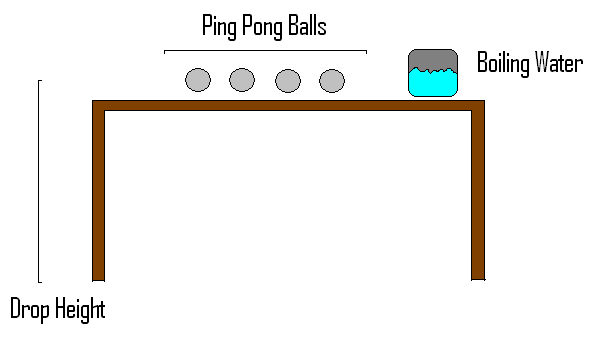The Effect Of Temperature Upon Ping-Pong Ball Bounce Height
Wasseem Salame
Physics
3A
Table Of Contents
Top
Background Information:
Ping pong balls are composed of a celluloid material, while not a true plastic it is formed by a mixture of camphor along with nitrocellulose (“Celluloid”). Hollow within, ping pong balls may have varying internal air pressures. Ping balls have a coefficient of restitution varying from 0.89 to 0.92 (ITTF).
Coefficient of restitution refers to the proportion of an object’s velocity prior and after an impact — primarily utilized in quantifying the “bounceability” or elasticity of an object. (McGinnis, Peter).
Statement of The Problem (And Variables):
The intent of this investigation is to determine the effect temperature has upon the bounce height of a ping pong ball. As such one would be able to graphically represent this function and potentially determine an optimal temperature value for the most superior bounce height.
Statement of The Hypothesis:
Should the temperature of a ping pong ball with a coefficient of restitution of 0.82 alter, then the bounce height will positively proportional to the temperature such that an increase of heat will cause for a greater bounce height, for the increase of kinetic energy will allow the ping pong ball to become more elastic. This is hypothesised to be true until the point of “ping-pong-ball-instability”, where the ball approaches a temperature that is too severe for it to retain its solid physical state.
Method
Design Of Experiment:
The experiment is intended to determine the effect of temperature against ping pong ball bounce height. As such, multiple ping pong balls of the identical manufacturer (and with a constant coefficient of restitution) will be utilized. Logger Pro software shall be implemented for the purposes of reducing and perhaps negating human error.
Experimental Apparatus:
Top
Procedure:
Top
Data Table:
|
Trial |
1 |
2 |
3 |
4 |
5 |
Average |
|
Temp (°C) |
Bounce Height (m) |
|
|
|
|
|
|
0 |
0.58 |
0.51 |
0.53 |
0.59 |
0.62 |
0.57 |
|
20 |
0.62 |
0.61 |
0.60 |
0.59 |
0.61 |
0.61 |
|
40 |
0.43 |
0.44 |
0.44 |
0.42 |
0.41 |
0.42 |
|
60 |
0.38 |
0.37 |
0.37 |
0.39 |
0.38 |
0.37 |
|
80 |
0.31 |
0.36 |
0.35 |
0.35 |
0.36 |
0.35 |
Top
Graph:
Top
Conclusion
General Conclusion:
As a result of experimentation, one has come to conclude that the hypothesized notion is in fact incorrect. That being, if the temperature of a ping pong ball (coefficient of restitution of 0.82) alter, then the bounce height will be positively proportional to the temperature where an increase of heat will allow for a greater bounce height, as the increase of kinetic energy will allow the ping pong ball to become more elastic. Observing the graph, one notices that there is in fact a linear proportion of temperature against bounce height, however, the relation is negative unlike that which had been proposed in the hypothesis. The coefficient of correlation is 0.82 suggesting a relatively accurate linear relationship. One might notice that the temperature of 20°C has the greatest bounce height average of the other temperatures. This is believed to be a result of engineering optimization as the purpose of the ping pong balls is to be utilized in the game of table tennis within indoor environments. With this notion in mind, and the graph results, it is now understood that there is in fact a negative correlation involving temperature against ping pong ball bounce height, and that the outlying average at 20°C is explained by the optimization of ping pong balls; from this one concludes that bounce height of a ping pong ball is not only determined by kinematics, though material physics as well.
Evaluating Procedures
Various procedural errors exist within the experiment. A prominent instance being that of assumed ping pong ball temperature. To elaborate, it is assumed that the ping pong balls were the same temperature as the medium they had been placed in, where in reality, they weren’t exactly that temperature. According to Newton’s Law of Cooling, the contact of ping pong ball against their cooling or heating medium would cause for a rapid heat exchange that gradually slows as a function of time. As such, the ping pong balls approached the temperature of their respective mediums, though never matched precisely.
Improving The Investigation
Various errors exist in the experiment such as that of instrumental. For instance, temperature had been measured utilizing a thermometer. This results in a standard uncertainty of ± 0.5 °C. Should a digital thermometer been used, the uncertainty would be reduced tenfold, and even furthermore had an accurate probe been utilized.
To further improve the results, it would be more ideal to have conducted the experiment within an environment that is standardized (with standard pressure and room temperature). The state of the conducted experiment involved a room at 20.1°C ± 0.5°C
in a 760 torr environment.
Ultimately, these errors do not severely impact the produced results, though would reduce uncertainty and negate errors if resolved.
Works Cited:
"Celluloid." MetaFilter. Meta Filter Network, 12 Dec. 2013. Web. 14 Jan. 2015.
"ITTF Technical Leaflet T1: The Table" (PDF). ITTF. May 2013.
McGinnis, Peter M. (2005). Biomechanics of sport and exercise Biomechanics of sport and exercise (2nd ed.). Champaign, IL
Diagram
 Diagram Zoomed
Diagram Zoomed
Related Links
Provides information regarding an experiment done involving ping pong balls and their bounce height.
Ping Pong Ball DynamicsDescribes the motion of ping pong balls depending on their drop angle
Ping Pong Ball Temperature EffectsA similar experiment regarding temperature and bounce height
Ping Pong Ball FactorsDetails various factors that may improve bounce heights.
Further Temperature EffectsAnother temperature based experiment to validate data